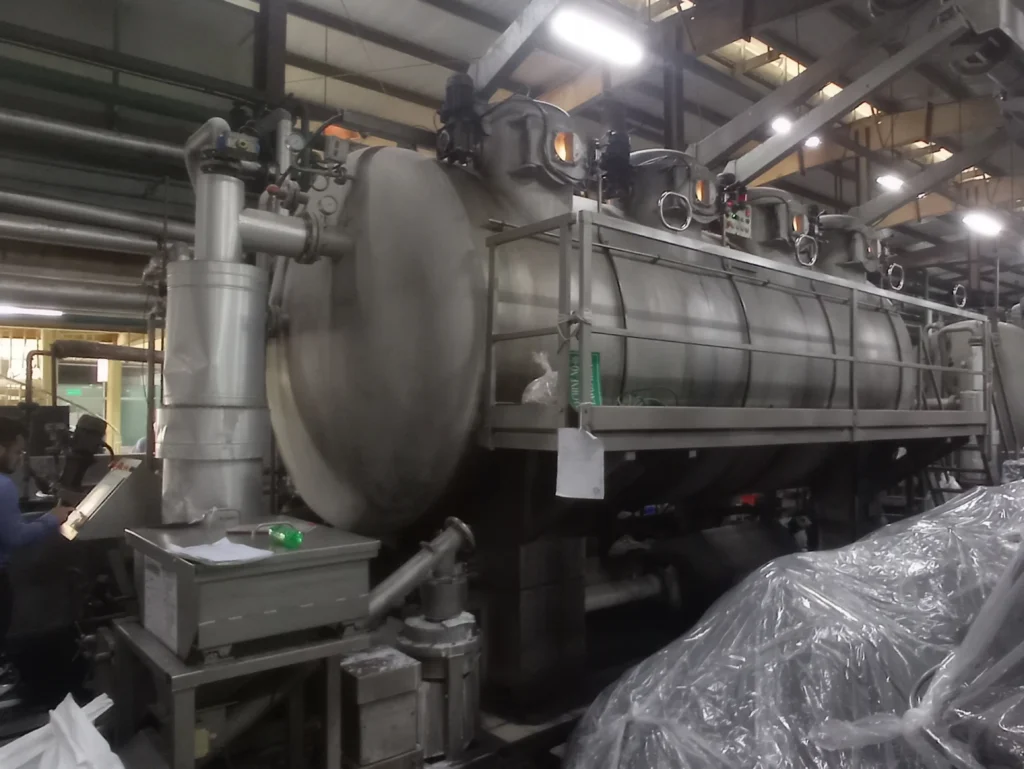
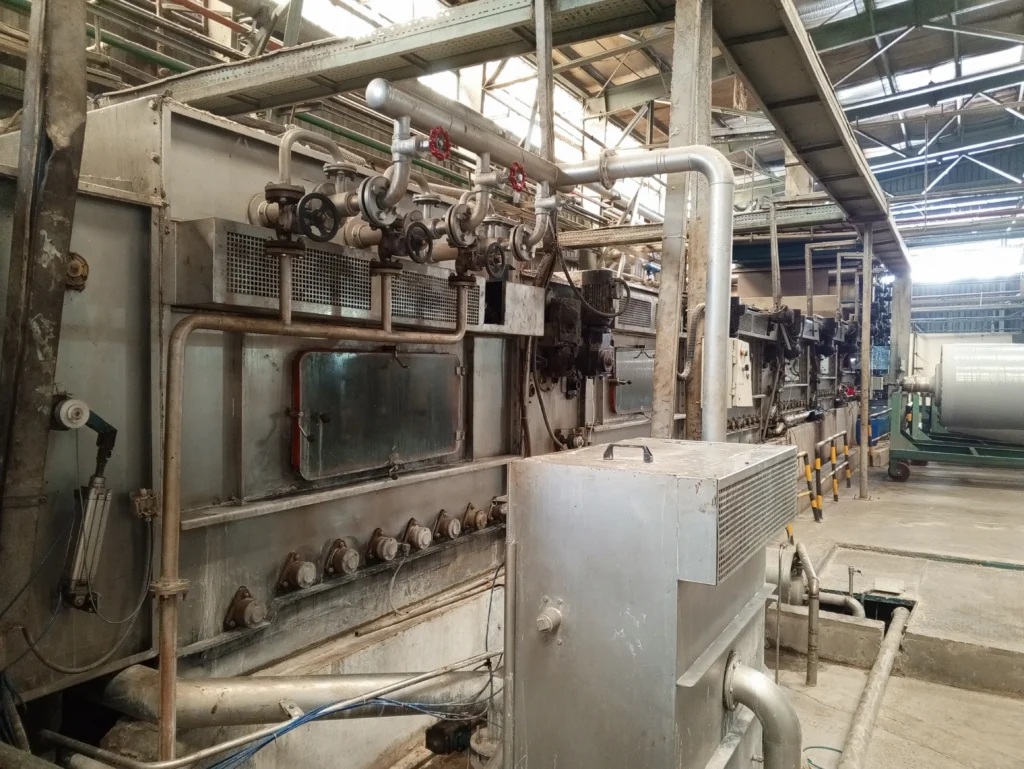
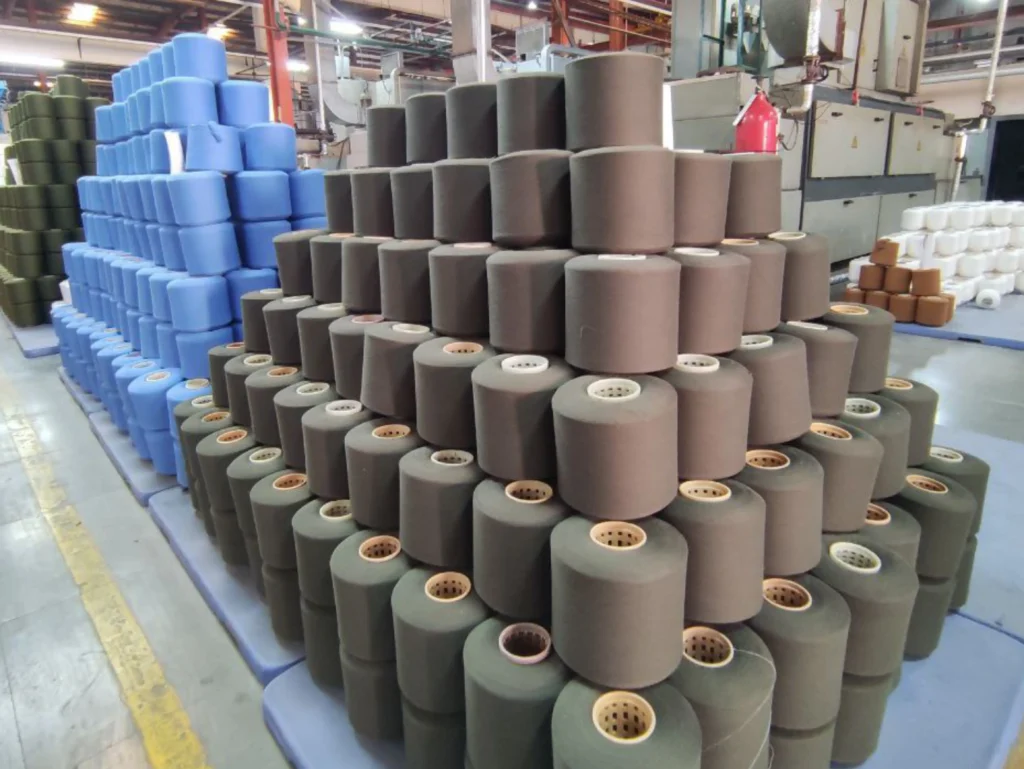
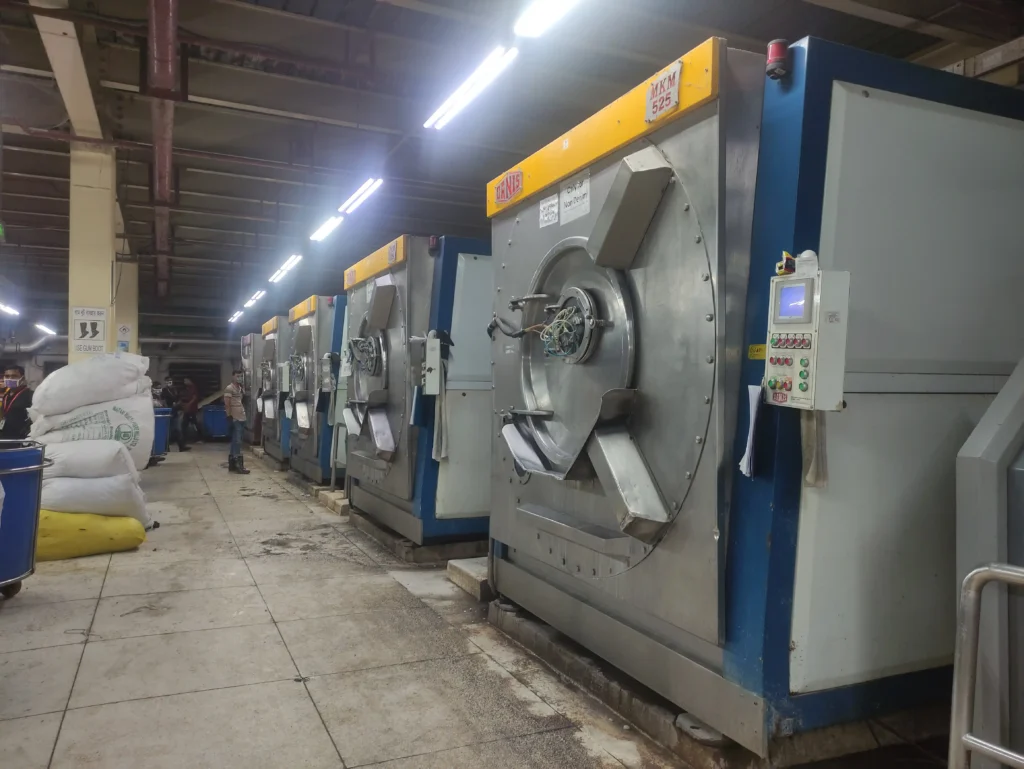
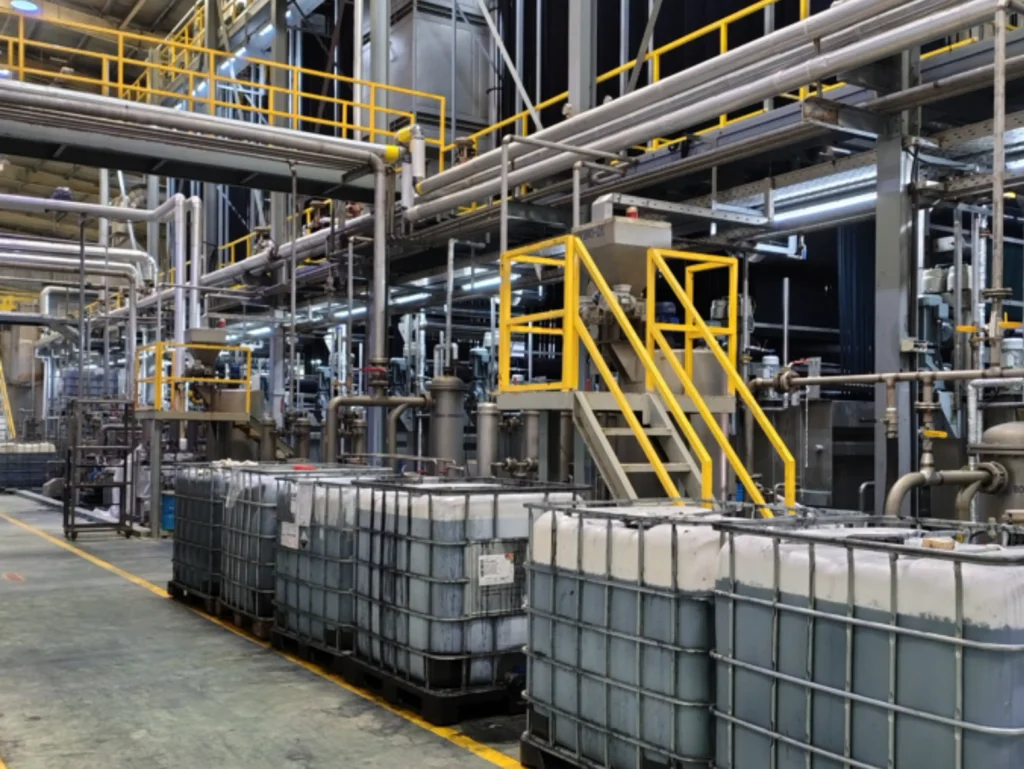
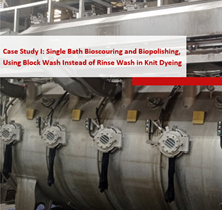
In the pretreatment, total 6 baths are usually required for the pretreatment before the dyeing step: scouring-bleaching + hot wash + rinse wash + peroxide killing and neutralization + enzyme biopolishing + rinse wash. After dyeing, 2 rinse wash steps are usually required. After neutralization and soaping, 2 rinse wash steps and fixing are usually required, such as 2 rinse wash + 1 bath for fixing.
The conventional dyeing process of single-part cotton knit fabric with black colour has been modified by introducing bioscouring instead of conventional scouring, combining the bioscouring and biopolishing steps in the same bath. Moreover, water consumption was reduced using block wash instead of rinse wash. In a winch dyeing machine, a 5-minute rinse wash typically consumes around 9-10 L/kg of water. In contrast, a block wash requires only 4-5 L/kg of water, reducing water consumption by half.
In the pretreatment, total 3 baths was used, such as Bio-scouring + enzyme biopolishing + 1 hot wash + 1 block wash. After dyeing total 4 wash steps was required: 1 hot wash + 3 block wash. After neutralization and soaping, total 4 wash steps and fixing are required: 1 hot wash + 3 block washes + 1 bath for fixing
40% Water (L/kg)
13% Electricity (kWh/kg)
13% Steam (kgs/kg)

Conventional enzyme wash process for denim garments using front loading washing machine starts by enzyme washing step. Then consecutive rinses are done to wash away the residuals. Conventionally, each step is carried on by using 1:4 liquor ratio.
It is common to do bleach wash after enzyme wash in denim garment washing in conventional washing process for denim garments using front loading washing machine. After enzyme wash, one rinse wash and one cleaning step are usually performed to wash away the unwanted residues. Then bleaching is done and two consecutive rinse washes are given for removing the unwanted residual chemicals. To neutralize the bleaching agent, neutralization step is done and again two rinse washes are given. Finally, a cleaning step followed by two rinse washes are given to complete the process.
In the acid wash for non-denim garments using belly machine, garments are usually washed using pumice stone or thermoplastic balls presoaked in a solution of potassium permanganate. After acid wash, the potassium permanganate is neutralized using sodium metabisulphite in the neutralization step. Then two times rinse wash is done to clean the residue chemicals. 6 L/kg or more water is used in neutralization and rinse steps.
Enzyme washing process has been modified by reducing the liquor ratio to 1:3 from 1:4 for each step.
Conventional washing process for denim garments using front loading washing machine was modified by combining the cleaning step of enzyme wash with the bleaching step. By this intervention, one extra bath used for cleaning is eliminated. Additionally, integrating the final cleaning step with the bleach neutralization process has eliminated the need for a separate cleaning step with two subsequent rinses.This modification reduced the number of total baths from 12 to 8.
The conventional dark bleach wash was modified by eliminating the two rinse washes after acid rinse. Moreover, water consumption was reduced by reducing liquor ratio from 1:4 to 1:3 in the process steps after neutralization. For the light bleach wash, the number of process steps remained the same as before but the liquor ratio was reduced from 1:4 to 1:3 for each step after neutralization.
Modified acid wash for non-denim garments using belly machine resulted in a reduced liquor ratio from 6 L/kg to 4 L/kg in neutralization and rinse steps. Modified acid wash for non-denim garments using front loading machine resulted in eliminating two rinse wash steps after acid wash and reducing the liquor ratio from 4 L/kg to 3 L/kg in the two rinse steps after neutralization.
35% Water (L/kg)
18.5% Electricity (kWh/kg)

In woven fabric textile finishing industries, Caustic Recovery Plant (CRP) is installed to concentrate dilute caustic soda solution (weak lye) discharged from the mercerizing machines. The weak lye having a concentration of 5 to 10°Bé is converted into strong lye having 20-25°Bé concentration. This process is conducted by evaporating water from the weak lye through evaporators.
Condensate is the liquid formed when steam passes from the vapor to the liquid state. In a heating process, condensate is the result of steam transferring a portion of its heat energy, known as latent heat, to the product being heated. Weak lye is heated by steam. As a result, the steam transfers its latent heat and turns into condensed water known as steam condensate. At the same time, the weak lye collects the latent heat from steam and its water portion turns into vapor. This vapor is condensed into hot water through condensers and can be found as vapor condensate.
Both these steam and vapor condensates are hot water having a high temperature of about 100°C. Generally, this hot water and heat are wasted in the industry.
To reuse the condensate, condensate line was connected to a hot water reserve tank. Both the steam and vapor condensates were pumped to the hot water reserve tank and then the water is directed to boiler feed by gravitational force.
In the pretreatment, total 3 baths was used, such as Bio-scouring + enzyme biopolishing + 1 hot wash + 1 block wash. After dyeing total 4 wash steps was required: 1 hot wash + 3 block wash. After neutralization and soaping, total 4 wash steps and fixing are required: 1 hot wash + 3 block washes + 1 bath for fixing
100% Water (L/kg)
83% Electricity (kWh/kg)

The dyeing of single-part cotton yarn with reactive dyes usually consists of three stages: pretreatment, dyeing, and aftertreatment. The yarn needs to be ready for the subsequent dyeing colouration. Thus, yarn undergoes several processes collectively called pretreatment, Pretreatment stage includes scouring-bleaching. Scouring-bleaching is required to remove the unwanted oil-wax and colour matters of the cotton fibres. The dyeing stage includes application of dyes to the yarn. Aftertreatment, the last stage, includes neutralization, soaping and application of fixing and softening chemicals. Lastly, fixing and softening chemicals are applied to increase the colour fastness and softness of the yarn after dyeing.
The conventional pretreatment generally requires four steps, each requiring one bath. The first bath treats the yarn with sodium hydroxide and hydrogen peroxide to remove the impurities from the yarn, the second bath washes the yarn with hot water, the third bath treats the yarn with acid to neutralize its pH. Finally, the fourth bath treats the yarn with a reducing agent to deactivate the residual hydrogen peroxide in the yarn which is known as peroxide killing.
75% Water (L/kg)
87% Electricity (kWh/kg)
84% Steam (kgs/kg)

Traditional All Over Printing (AOP) demands water in flat bed, rotary AOP printing machines’ blanket washing, screen washing. Mostly fresh water is used regardless of processes though having the option to use ETP water.
Rotary and flatbed printing machines are usually used for the continuous printing of fabrics. The printer table blanket is washed with forced water jets. The washing is done by means of multiple nozzles to remove the stains adhered to the blanket during printing operation. Generally, the control of blanket washing water at the printing machines is manual. So, the washing is kept on running due to negligence and wasted though the machine is stopped. This happens during maintenance or change over and causes significant water waste.
Fresh water is showered with force to clean the blanket of AOP machines. Generally, that fresh water only being used once is drained despite its potential of reuse.
After printing the fabric, printing screen is often stained with many chemicals and ink. Therefore, before printing a new batch, they must be cleaned off. Currently, many factories often wash screens under direct running water with large uncontrolled flow. This practice wastes a lot of water.
Modified process reusing ETP water in blanket washing, screen and drum cleaning was implemented by connecting the ETP outlet to a pump which directs the water to an overhead reserve tank. Then the water was directed to AOP floor by gravitational force.
This water wastage was avoided by installing automatic water shut off valve at the printing machines. Whenever printing machine is stopped, the blanket washing water also stops coming from the nozzles.
The blanket washing water that is drained after washing the blanket was reused by filtering. If majority of the orders are pigment printing, then it is easily possible to implement this technique and save water.
Trigger nozzles was installed with hosepipes for different cleaning purposes. Installation of water trigger nozzles that only release water when pressure is applied or rotated stopped unnecessary waste of water.
In the pretreatment, total 3 baths was used, such as Bio-scouring + enzyme biopolishing + 1 hot wash + 1 block wash. After dyeing total 4 wash steps was required: 1 hot wash + 3 block wash. After neutralization and soaping, total 4 wash steps and fixing are required: 1 hot wash + 3 block washes + 1 bath for fixing
85% Water (L/kg)
20% Electricity (kWh/kg)